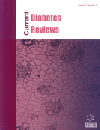- Home
- A-Z Publications
- Current Diabetes Reviews
- Previous Issues
- Volume 10, Issue 3, 2014
Current Diabetes Reviews - Volume 10, Issue 3, 2014
Volume 10, Issue 3, 2014
-
-
Diabetes Mellitus Induced Impairment of Male Reproductive Functions: A Review
More LessAuthors: Ram Niwas Jangir and Gyan Chand JainDiabetes mellitus (DM) represents one of the greatest threats to human health all over the world. The incidence of DM is rising rapidly also including children and young persons of reproductive age. Diabetes has been associated with reproductive impairment in both men and women. Diabetes may affect male reproductive functions at multiple levels as a result of its effects on the endocrine control of spermatogenesis, steroido Read More
-
-
-
ALA, Fatty Fish or Marine n-3 Fatty Acids for Preventing DM?: A Systematic Review and Meta-Analysis
More LessAuthors: Arti Muley, Prasad Muley and Monali ShahDiabetes mellitus (T2DM) has become a global problem. Role of n-3 FA in its prevention is still not completely understood. We carried out this systematic review and meta-analysis to assess the relation of dietary intake of fish and n-3PUFA with risk of diabetes. We searched PUBMED, EMBASE and GOOGLE with cross references to identify relevant articles. Since no RCTs were available, we searched for prospective coho Read More
-
-
-
Neurotrophic Factors for Retinal Ganglion Cell Neuropathy - With a Special Reference to Diabetic Neuropathy in the Retina
More LessAuthors: Guzel Bikbova, Toshiyuki Oshitari, Takayuki Baba and Shuichi YamamotoDiabetes mellitus is a disease with a devastating impact on population. Recent data revealed that early retinal neuropathy in patients with diabetic retinopathy involved a reduced expression of brain-derived neurotrophic factor. Retinal ganglion cells (RGC) neuropathy is a progressive optic nerve neuropathy with RGC death and axonal degeneration, and it leads to blindness in the elderly population worldwide. Thus, neuroprotectiv Read More
-
-
-
The pH of Wound Fluid in Diabetic Foot Ulcers- the Way Forward in Detecting Clinical Infection?
More LessAuthors: Carla McArdle, Katie M. Lagan and David A. McDowellInfections within diabetic foot ulcers are often hard to detect and extremely difficult to treat. The normal signs and symptoms of infection including purulence, erythema, pain, tenderness, warmth and induration are frequently absent in such wounds necessitating exploration of other ways of rapidly and accurately detecting infection. This study considers diabetic wound fluid pH as a possible alternative means of monitoring inf Read More
-
-
-
Hyperglycemia to Nephropathy via Transforming Growth Factor Beta
More LessAuthors: Mayuresh Sudamrao Garud and Yogesh Anant KulkarniNephropathy is one of the major complications of diabetes which further directs to end stage renal disease. Extensive work has been done to find out the mechanisms involved in pathogenesis of the DN. Now, many researchers have been convinced that almost all of the molecular mediators and intracellular signaling pathways involved in progression of diabetic nephropathy have involvement in transforming growth factor bet Read More
-
-
-
Understanding and Modulating the Toll Like Receptors (TLRs) and NOD Like Receptors (NLRs) Cross Talk in Type 2 Diabetes
More LessAuthors: Bhumika Prajapati, Prasant Kumar Jena, Parth Rajput, Kaveri Purandhar and Sriram SeshadriObesity and Type 2 diabetes are leading health problems which are characterized by low-grade inflammation with an increase in inflammatory cytokines along with the change in the gut microbiota population. Toll like Receptors (TLRs) and NOD like Receptors (NLRs) are very prominent pathogen recognition receptors, which play a significant role in the innate immune system. Both TLRs and NLRs pathways are mediated Read More
-
-
-
Vascular Endothelial Dysfunction and Nutritional Compounds in Early Type 1 Diabetes
More LessCardiovascular disease is the major cause of death in patients with type 1 diabetes. Vascular endothelial dysfunction is an early pathophysiological precursor of cardiovascular disease. There is extensive evidence that hyperglycemia causes acute perturbations in endothelial function likely due to increases in oxidative damage. Interestingly, oscillating hyperglycemia may cause more damage than persistent hyperglycemia. Many, Read More
-
-
-
Bariatric Surgery - Effects on Obesity and Related co-Morbidities
More LessAuthors: Maria Saur Svane and Sten MadsbadLaparoscopic adjustable gastric banding (LAGB), laparoscopic Roux-en-Y gastric bypass (RYGB) and laparoscopic sleeve gastrectomy (SG) are the three most commonly performed bariatric procedures. Obesity responds well to bariatric surgery, with major long-lasting weight loss that is most pronounced after RYGB and SG, where the mean weight loss is about 40 kg or 15 body mass index (BMI) units. Some of the benefits afte Read More
-
Volumes & issues
-
Volume 21 (2025)
-
Volume 20 (2024)
-
Volume 19 (2023)
-
Volume 18 (2022)
-
Volume 17 (2021)
-
Volume 16 (2020)
-
Volume 15 (2019)
-
Volume 14 (2018)
-
Volume 13 (2017)
-
Volume 12 (2016)
-
Volume 11 (2015)
-
Volume 10 (2014)
-
Volume 9 (2013)
-
Volume 8 (2012)
-
Volume 7 (2011)
-
Volume 6 (2010)
-
Volume 5 (2009)
-
Volume 4 (2008)
-
Volume 3 (2007)
-
Volume 2 (2006)
-
Volume 1 (2005)
Most Read This Month
Article
content/journals/cdr
Journal
10
5
false
en


